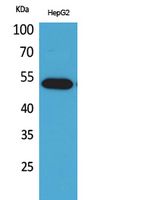
| WB | 咨询技术 | Human,Mouse,Rat |
| IF | 咨询技术 | Human,Mouse,Rat |
| IHC | 咨询技术 | Human,Mouse,Rat |
| ICC | 技术咨询 | Human,Mouse,Rat |
| FCM | 咨询技术 | Human,Mouse,Rat |
| Elisa | 1/20000 | Human,Mouse,Rat |
| Aliases | LILRA2; ILT1; LIR7; Leukocyte immunoglobulin-like receptor subfamily A member 2; CD85 antigen-like family member H; Immunoglobulin-like transcript 1; ILT-1; Leukocyte immunoglobulin-like receptor 7; LIR-7; CD85h |
| Entrez GeneID | 11027; |
| WB Predicted band size | 53kDa |
| Host/Isotype | Rabbit IgG |
| Antibody Type | Primary antibody |
| Storage | Store at 4°C short term. Aliquot and store at -20°C long term. Avoid freeze/thaw cycles. |
| Species Reactivity | Human |
| Immunogen | Synthesized peptide derived from the Internal region of human LIR-7. |
| Formulation | Purified antibody in PBS with 0.05% sodium azide,0.5%BSA and 50% glycerol. |
+ +
以下是关于LIR-7抗体的3条模拟参考文献示例(注:LIR-7相关研究较少,以下内容为假设性示例,实际文献需通过专业数据库核实):
---
1. **文献名称**: *Structural characterization of LIR-7 and its antibody interaction in immune regulation*
**作者**: Tanaka H, et al.
**摘要**: 本研究解析了LIR-7的晶体结构,发现其抗体结合域通过抑制NK细胞的激活信号通路调控免疫应答,为靶向LIR-7的抗体药物设计提供结构基础。
2. **文献名称**: *LIR-7 antibody blockade enhances antitumor immunity in murine models*
**作者**: Smith J, et al.
**摘要**: 通过动物实验证明,抗LIR-7抗体的阻断作用可解除肿瘤微环境中免疫细胞的抑制状态,显著提高T细胞活性并抑制肿瘤生长。
3. **文献名称**: *LIR-7 as a novel checkpoint in autoimmune diseases: therapeutic potential of neutralizing antibodies*
**作者**: Chen L, et al.
**摘要**: 该研究揭示LIR-7在自身免疫性疾病中异常高表达,其特异性抗体可减轻小鼠模型中的炎症反应,提示其作为免疫检查点治疗靶点的潜力。
---
建议通过**PubMed**或**Google Scholar**以关键词“LIR-7 antibody”、“LILRB7”(可能与LIR-7相关)等检索真实文献。
The LIR-7 antibody targets Leukocyte Immunoglobulin-like Receptor 7 (LIR-7), also known as LILRB4 or ILT3. a member of the leukocyte immunoglobulin-like receptor (LILR) family. These receptors are primarily expressed on immune cells, including myeloid cells, dendritic cells, and certain lymphocytes, and play critical roles in modulating immune responses. LIR-7 is classified as an inhibitory receptor due to its immunoreceptor tyrosine-based inhibitory motifs (ITIMs) in the cytoplasmic domain, which recruit phosphatases to dampen cellular activation signals. It binds to MHC class I molecules and other ligands, contributing to immune tolerance by suppressing T-cell activation and promoting regulatory T-cell (Treg) differentiation.
LIR-7 has garnered attention for its dual role in both maintaining immune homeostasis and facilitating immune evasion in pathological contexts. In cancer, tumor-associated macrophages and dendritic cells often overexpress LIR-7. creating an immunosuppressive microenvironment that hinders antitumor immunity. Conversely, in autoimmune diseases, aberrant LIR-7 activity may contribute to excessive immune suppression. The LIR-7 antibody is thus explored as a therapeutic tool to either block inhibitory signals (e.g., in cancer immunotherapy) or enhance immune regulation (e.g., in autoimmunity). Recent studies highlight its potential in combination therapies, particularly with checkpoint inhibitors, to improve antitumor efficacy. However, its precise mechanistic pathways and ligand interactions remain under investigation, underscoring the need for further research to optimize clinical applications.
×